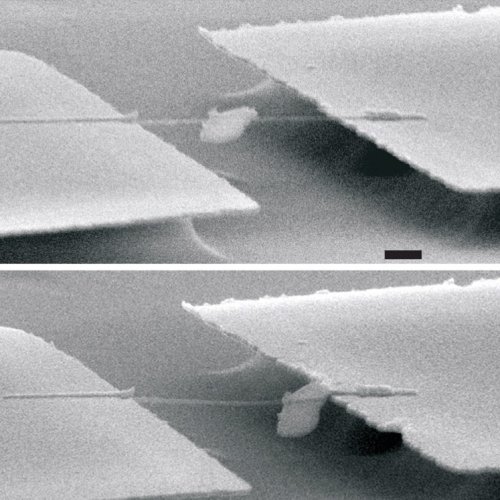
Researchers in Europe have built a “monorail” from carbon nanotubes that can transport a fleck of metal over a distance of about 800 nm. The metal cargo sits on a 5-nm long nanotube “sleeve” surrounding a much longer nanotube “rail” that is stretched across a trench in a silicon chip. Surprisingly, the team believes the sleeve is driven by lattice vibrations called phonons — rather than electrical interactions, which they originally thought would propel the device.
Carbon nanotubes are sheets of carbon one atom thick that are rolled up into tubes that are only several nanometres in diameter. Adrian Bachtold and colleagues at the Autonomous University of Barcelona along with collaborators at the University of Vienna and the Swiss Federal Institute of Technology in Lausanne built their device using a multiwalled nanotube, which comprises several concentric nanotubes (Science DOI: 10.1126/science.1155559) .
The team began by attaching a 1500-nm long multiwalled tube across the trench with metal electrodes. They then used an electrical-breakdown technique to remove several outer layers from most of the nanotube, leaving a short sleeve that could rotate freely and move to and fro along the inner rail.
Hotter in the middle
The team operate the motor by passing an electrical current through the rail, which causes it to heat up. However, the region of the rail in the middle of the trench becomes much hotter than the ends — because the electrodes act as heat sinks. If the sleeve and its cargo — a tiny piece of gold — are placed in the middle of the trench, they will move to one side of the trench at speeds of up to 1 µm/s.
This is a beautiful experimental resultRamin Golestanian, University of Sheffield
Bachtold told physicsworld.com that the team had originally hoped that they could apply a voltage between the electrodes to encourage atomic interactions between the rail and sleeve, causing the sleeve to move in a helical manner in one direction — and then in the other direction when they reversed the voltage. Such motion was expected, according to Bachtold, because the atoms on the inner and outer nanotubes would both be arranged in slightly different spiral configurations.
Instead, the team found that the sleeve always moved away from the centre of the trench. According to Bachtold, the first clue that heat was driving the motion was that the gold cargo particle changed shape by partially melting. The team confirmed the role of heating by doing computer simulations of the system.
Phonon propulsion
Heat is transported through carbon nanotubes in the form of quantized lattice vibrations called phonons, which behave much like particles. Copious numbers of phonons are created at the hot centre of the rail and move towards both electrodes, striking the outer sleeve and dragging it along with them.
Ramin Golestanian of the University of Sheffield describes the work as “a beautiful experimental result”. However Golestanian, who studies the physics of moving nanoparticles and nanomechanical devices, told physicsworld.com that much more investigation is required to understand the mechanism responsible for the motion and the role of phonons in it.
Bachtold and colleagues have now turned their attention to making more practical motors based on the effect. They are currently working on reversible devices in which one end of the rail is heated and the other is not, which should cause the sleeve to move from the hot end to the cold end. The direction of travel could be reversed by simply switching which end is heated.
In the longer term, Bactold believes that such motors could be used to drive nanometre-sized machines, such as those that perform drug delivery or other medical functions in the body.



